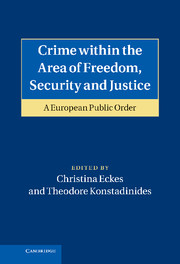Book contents
- Frontmatter
- Contents
- Contributors
- Acknowledgements
- ABBREVIATIONS
- Introduction
- 1 EU criminal justice: beyond Lisbon
- 2 The European Union policy against corruption in the light of international developments
- 3 The EU's anti-money laundering agenda: Built on risks?
- 4 EU anti-money laundering regulation: Multilevel cooperation of public and private actors
- 5 The legal framework of the European Union's counter-terrorist policies: full of good intentions?
- 6 Organised crime: developments and challenges for an enlarged European Union
- 7 The Europeanisation of extradition: how many light years away to mutual confidence?
- 8 The European Evidence Warrant: Mutual Recognition and Mutual (Dis)Trust?
- 9 Law and order and internal security provisions in the Area of Freedom, Security and Justice: before and after Lisbon
- 10 The external dimension of the EU's Area of Freedom, Security and Justice
- Index
- References
9 - Law and order and internal security provisions in the Area of Freedom, Security and Justice: before and after Lisbon
Published online by Cambridge University Press: 01 June 2011
- Frontmatter
- Contents
- Contributors
- Acknowledgements
- ABBREVIATIONS
- Introduction
- 1 EU criminal justice: beyond Lisbon
- 2 The European Union policy against corruption in the light of international developments
- 3 The EU's anti-money laundering agenda: Built on risks?
- 4 EU anti-money laundering regulation: Multilevel cooperation of public and private actors
- 5 The legal framework of the European Union's counter-terrorist policies: full of good intentions?
- 6 Organised crime: developments and challenges for an enlarged European Union
- 7 The Europeanisation of extradition: how many light years away to mutual confidence?
- 8 The European Evidence Warrant: Mutual Recognition and Mutual (Dis)Trust?
- 9 Law and order and internal security provisions in the Area of Freedom, Security and Justice: before and after Lisbon
- 10 The external dimension of the EU's Area of Freedom, Security and Justice
- Index
- References
Summary
INTRODUCTION
The maintenance of law and order and the safeguarding of internal security are competences at the very core of national sovereignty. The Member States have tried to keep both the EC and the EU from impinging upon the exercise of these responsibilities by introducing several provisions to such effect in the Treaties. Unsurprisingly, the Member States' concerns in this regard reach their peak within the framework of the Area of Freedom, Security and Justice (AFSJ); this is understandable, given the extent to which ‘the European Union has increased its role in securing police, customs and judicial cooperation and in developing a coordinated policy with regard to asylum, immigration and external border controls’ over the past years.
In terms of general judicial control, the AFSJ itself has come a long way since the creation of the third pillar at Maastricht, where the Court was given little jurisdiction in this field. The Treaty of Amsterdam subsequently extended the jurisdiction of the Court to the third pillar (Title VI TEU) and to the new provisions on visa, asylum and immigration policies, which previously fell within the third pillar and were then transferred to the first one (Title IV, Part Three of the EC Treaty – hereafter Title IV TEC). There are special judicial arrangements in place for the whole of the AFSJ, be it in the first or in the third pillar, that limit the jurisdiction of the ECJ.
- Type
- Chapter
- Information
- Crime within the Area of Freedom, Security and JusticeA European Public Order, pp. 249 - 271Publisher: Cambridge University PressPrint publication year: 2011
References
- 1
- Cited by



